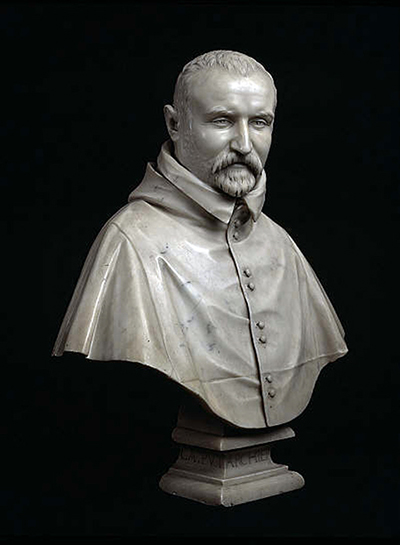The bust of Carlo Antonio del Pozzo by Bernini was commissioned by del Pozzo's nephew, Cassiano dal Pozzo, some time between 1622 and 1664.
Although the sculpture was created some 15 years after the death of Carlo Antonio del Pozzo, the techniques used to sculpt this marble bust mean that it is incredibly lifelike and powerful; the differences in texture between hair, fabric and skin are clearly defined. Bernini is considered to be one of the masters in reproducing textures using marble, and was rightly exalted as one of the pioneers of this era. Evidence of his unique ability is abundant in this piece, which displays an almost photographic level of realism.
In the bust of Carlo Antonio del Pozzo, Del Pozzo is wearing a prelate's robe (he was an Archbishop of Rome until his death in 1607); the fine details on the fabric and buttons of the robe lend authenticity to this hyper-realistic piece. The slight tilt of the head, and grave, stern expression contribute to the lifelike appearance of the subject, despite more than a decade having passed between his death and the sculpture being created.
The sculpture, like the majority of Gian Lorenzo Bernini's work, is in the baroque style. As Bernini was a child prodigy (starting his career at just eight years old), little is known about his possible influences, although his own father was a sculptor which is likely how his talent was discovered. Widely considered to be the most prominent Pan-European baroque sculptor of his times, those who Bernini influenced are far more numerous and well documented. It is known that his contemporary students included his own brother (Luigi Bernini), Giuliano Finelli, Giacomo Antonio Fancelli, Andrea Bolgi, Stefano Speranza and Francois Duquesnoy. Giulio Cartari was considered to be his most trusted student.
As well as the impact that he had on individuals, Bernini was hugely influential within several art movements including Rococo, Baroque and Neoclassicism. As he was not only a sculptor and artist but an architect, his physical imprint on the City of Rome is still visible today. St Peter’s Basilica is arguably his most famous work, a true labour of love on which he spent more than 50 years; however, his contribution to the landscape of Rome is so comprehensive and enduring that tours are available specifically to take in both his art and architecture.
The bust of Carlo Antonio del Pozzo was housed in Castle Howard from 1715 onward, until it was acquired by the National Gallery Scotland. It was purchased by the gallery in 1986 for a total price £3 million, although many sources believed the actual value to be much higher, quoting a price of £7.5 million. The National Gallery used multiple income streams to raise funds for the purchase, including their own memorial fund, the J. Paul Getty Trust and private donations.




